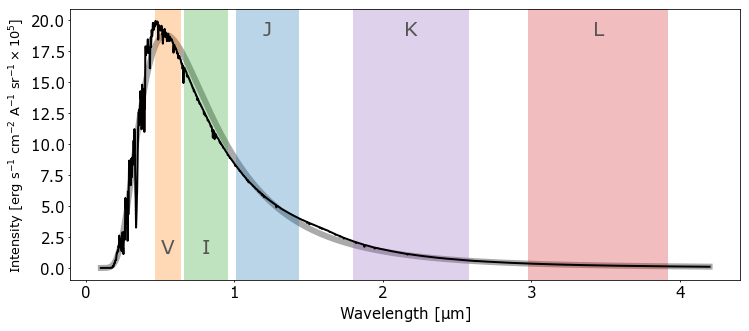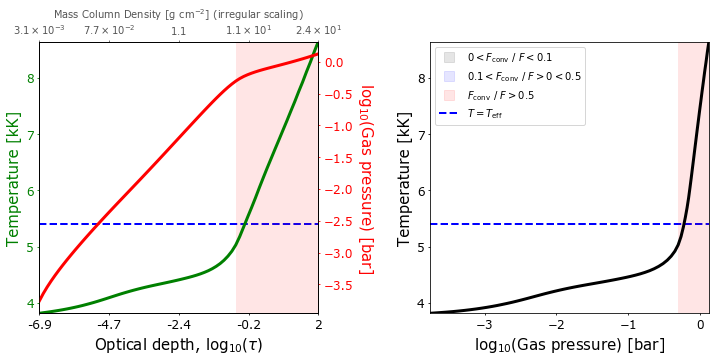Model Inspector
Model parameters
Show explanationsGeneral parameters
Software:
ATLAS 9 / SYNTHE
Software package that was used to produce this model
Effective temperature [K]:
5400.0
Effective surface temperature in Kelvin
Surface gravity [log(CGS)]:
4.75
Base-10 logarithm of surface gravity in CGS
Input data files
Rosseland checksum:
0e974d951e6cb7b2ed0eb0742221bcd1
MD5 checksum of the employed table of Rosseland mass absorption coefficients computed with KAPPAROS
ODF checksum:
246a7bb3a1525d44ec7075d49febf8ba
MD5 checksum of the employed ODFs (opacity distribution functions) computed with DFSYNTHE
Convection modelling
Convection status:
MLT with overshoot
ATLAS convection treatment. Note that overshooting may be disabled by setting its coefficient to zero (see below) regardless of this parameter
Mixing length [scale height]:
1.25
Convective mixing length in terms of local pressure scale heights
Overshoot coefficient [0..1]:
0.0
Overshooting coefficient between 0 (no overshoot) and 1 (maximum overshoot)
Convective layers:
36
Number of layers (counting from the bottom) where convection is allowed. This parameter suppresses numerical artifacts when evaluating the Schwarzschild criterion at low optical depths
Opacity settings
NLTE treatment:
Disabled
If disabled, treat all non-LTE (local thermodynamic equilibrium) lines with SYNTHE in LTE. If enabled, the lines may be directed to a different code for a non-LTE treatment
Total lines in spectrum:
105330200
Total number of lines considered in the spectrum calculation by SYNTHE
Molecules status:
Enabled
Include molecules in the ATLAS equilibrium calculation
Elemental composition
Hydrogen mass fraction, X [0..1]:
0.59949
Mass fraction of hydrogen (between 0 and 1)
Helium mass fraction, Y [0..1]:
0.4
Mass fraction of helium (between 0 and 1)
Metals mass fraction, Z [0..1]:
0.00051
Mass fraction of metals (between 0 and 1)
Elemental abundances, [A/M] [dex]:
Li
-03.00
Be
-00.00
B
-00.00
C
-00.65
N
+01.45
O
-00.10
F
-00.00
Ne
-00.00
Na
-00.00
Mg
-00.00
Al
-00.00
Si
-00.00
P
-00.00
S
-00.00
Cl
-00.00
Ar
-00.00
K
-00.00
Ca
-00.00
Sc
-00.00
Ti
-00.00
V
-00.00
Cr
-00.00
Mn
-00.00
Fe
-00.00
Co
-00.00
Ni
-00.00
Cu
-00.00
Zn
-00.00
Ga
-00.00
Ge
-00.00
As
-00.00
Se
-00.00
Br
-00.00
Kr
-00.00
Rb
-00.00
Sr
-00.00
Y
-00.00
Zr
-00.00
Nb
-00.00
Mo
-00.00
Ru
-00.00
Rh
-00.00
Pd
-00.00
Ag
-00.00
Cd
-00.00
In
-00.00
Sn
-00.00
Sb
-00.00
Te
-00.00
I
-00.00
Xe
-00.00
Cs
-00.00
Ba
-00.00
La
-00.00
Ce
-00.00
Pr
-00.00
Nd
-00.00
Sm
-00.00
Eu
-00.00
Gd
-00.00
Tb
-00.00
Dy
-00.00
Ho
-00.00
Er
-00.00
Tm
-00.00
Yb
-00.00
Lu
-00.00
Hf
-00.00
Ta
-00.00
W
-00.00
Re
-00.00
Os
-00.00
Ir
-00.00
Pt
-00.00
Au
-00.00
Hg
-00.00
Tl
-00.00
Pb
-00.00
Bi
-00.00
Th
-00.00
U
-00.00
Elemental abundances of metals in the atmosphere in dex with respect to metallicity-scaled solar values, [A/M]
Stratification
Number of layers:
72
Number of (plane-parallel) vertical layers in the stratification
Optical depth start:
-6.875
Base-10 logarithm of the shallowest optical depth (tau) in the calculation (upmost layer)
Optical depth step:
0.125
Additive step in optical depth (tau) between adjacent layers in the base-10 logarithmic space
Wavelength sampling
Frequency points:
337
Number of points considered by ATLAS in frequency integrals (e.g. Rosseland opacity)
High frequency point [A]:
90.9
Wavelength of the highest frequency point considered in frequency integrals by ATLAS
Low frequency point [A]:
1599999.9
Wavelength of the lowest frequency point considered in frequency integrals by ATLAS
Wavelength start [A]:
1000.001
Minimum wavelength in the requested spectrum output from SYNTHE in angstroms
Wavelength end [A]:
41999.9961
Maximum wavelength in the requested spectrum output from SYNTHE in angstroms
Resolution:
600000.0
Spectroscopic resolution in the requested spectrum output from SYNTHE
Broadening configuration
ATLAS turbulent velocity [km/s]:
2.0
Turbulent velocity in km/s in the ATLAS calculation. Note that SYNTHE may introduce additional broadening
SYNTHE turbulent velocity [km/s]:
0.0
Turbulent velocity in km/s in the SYNTHE calculation. Applied on top of ATLAS broadening. Velocities add in quadrature
Miscellaneous
Output medium:
Air
Vacuum or air wavelengths in the output spectrum
Feature cut-off:
0.0001
Minimum spectral feature intensity (as a fraction of the continuum) to be considered in the calculation
Synthetic Spectrum

Figure 1. Synthetic spectrum of the atmosphere. Isotropic intensity per unit surface area of the star per unit wavelength per unit solid angle. Shown in light gray is the blackbody spectrum
for the same effective temperature as the model (5400.0 K). Selected optical and near-IR photometric bands are highlighted.
Atmosphere Structure

Figure 2. Left: temperature (green) and gas pressure (red) as functions of the optical depth throughout the model atmosphere. Temperature is shown on a linear scale, while both optical depth
and pressure are logarithmic. For reference, an alternative horizontal scale is provided with markings in terms of mass column density instead of optical depth. Note that the alternative
scale corresponds directly to the optical depth scale and may therefore be irregular (i.e. neither logarithmic nor linear). Right: temperature as a function of pressure. The effective
temperature of the model (5400.0 K) is shown in blue in both plots. Strongly convective regions are highlighted.
Solution Convergence

Figure 3. Percent flux error in the model as a function of optical depth. The vertical axis is logarithmic and shows the absolute value of the error, while the sign is provided as a separate
plot. Temperature corrections in each iteration are carried out to minimize the error; however, some residuals will remain due to (1) incomplete/inaccurate physics, (2) numerical failures
and (3) insufficient number of iterations. For ATLAS models, flux errors below 1% are typically expected throughout the entire atmosphere in a well-converged model. At low temperatures,
flux errors up to 10% are sometimes tolerated in localized regions. For PHOENIX models, errors of a few percent are expected in radiative layers. In highly convective regions, the error
estimate is not representative of the model convergence and may rise to arbitrarily large values. Well-converged models usually show a smooth transition between the two regimes and are
free of oscillations.